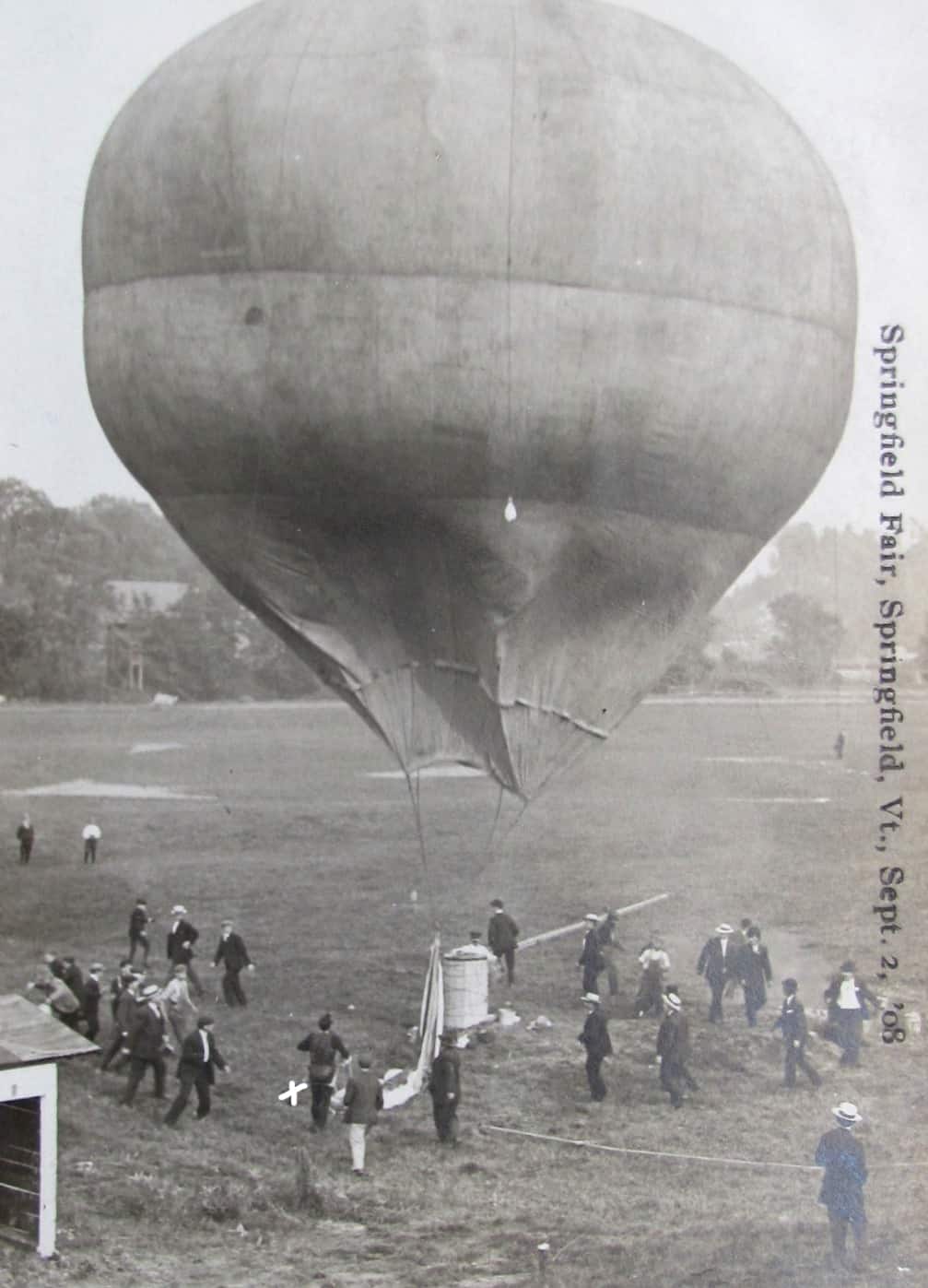
Here’s an unusual, real photo postcard of a balloonist at the Sept. 2, 1908 Springfield Fair. The fair was held where Riverside Middle School is today, hence Fairgrounds Road.
I called Hugh Putnam, of the Springfield Art and Historical Society, to see what he knew. Hugh said that they have the same postcard and another that shows a parachutist descending to earth. Hugh wasn’t sure whether the parachutist dropped from the balloon or an airplane.
I found a clue in the message written on the back of my postcard: “Here’s the balloon at our Springfield Fair. The one marked with X is Prof. Bonette, who made the ascension. I don’t like to see it. The second day he came down with his parachute not far from our house…”
From an online source:
“Prof. Bonette began his aeronautical career in the 1890s by giving parachute/balloon exhibitions at fairs and expositions around New England. His performances involved going aloft in his hot air balloon and then dropping from a pre-determined altitude using a parachute. In later years he devised a spring-loaded ‘cannon’ which hung from beneath the balloon. When the balloon had risen to the proper altitude, Bonette would appear to be fired from the cannon before parachuting safely to the ground. The stunt was actually an illusion created by fireworks and confetti to make it appear that the cannon had fired, but in reality no gunpowder was used.
“According to an interview given by Bonette to Alton H. Blackington in 1943, the professor made his first parachute drop at a fair in Plymouth, N.H., in 1893, after the featured aerialist took sick minutes before the scheduled performance, and Bonnete volunteered to act as a replacement.
“His second and third drops were made at the first meeting of the St. Johnsbury Gentlemen’s Driving Club held at the fairgrounds in St. Johnsbury, Vt., in October of 1893. (The club was for those who liked to race horses.)
“Being an aeronaut was not without its hazards, and it would seem that Professor Bonette had more than his share of close calls. The following are a few examples:
“While performing at the South Ryegate (Vermont) Fair during the third week of September, 1895, Bonette experienced a problem with his parachute line becoming entangled with one holding a sand bag used for ballast while he floated high in the air. He decided to cut the parachute loose thinking it would pull the tangled line free, but it didn’t.
“The Vermont Phoenix newspaper had this to say about the incident: ‘C. C. Bonette, the aeronaut, came very close near making his last ascension at St. Johnsbury recently, when, 5,000 feet in the air, he found that the balloon and parachute had by some means become connected by a string, but by great effort he succeeded in freeing himself just in time to save his life.’ Fortunately Bonette was not injured.
“Two months later, on Nov. 14, 1895, it was reported in the News And Citizen (a Morrisville, Vt. newspaper) that Professor Bonette had just completed a successful season as an aeronaut, having made 28 balloon ascensions since July 1, with only one accident. That accident occurred while he was performing in Pittsfield, Maine, when his balloon began to collapse while he was 300 feet in the air. Thinking quick, he dropped with his parachute, which opened in the nick of time to save his life, although he still made a ‘hard landing’ and received injuries which took a week to recover from.
“In June of 1899, Bonette’s balloon developed a leak while 200 feet in the air while he was performing at Ridgewood Park in Brooklyn, N.Y. Bonette dropped using a parachute which didn’t sufficiently open in time. He crashed into the top of an apple tree and suffered severe bruising, but no broken bones.
“The following September, while performing at the Rochester Fair in Rochester, N.H., Bonette suffered another accident. While preparing to take off in a balloon from which he intended to make a parachute drop, he told his assistants, ‘Goodbye boys, I’ll see you later, but how much later I don’t know.’ When the balloon was released, it rose quickly, but suddenly developed a small tear which allowed the hot air to begin escaping. The professor cut loose with his parachute, but it didn’t fully inflate until he was almost to the ground. He struck the earth hard…”
This week’s old saying is from Iggy: “If at first you don’t succeed… so much for skydiving.”
Iggy is one of Henry’s friends.